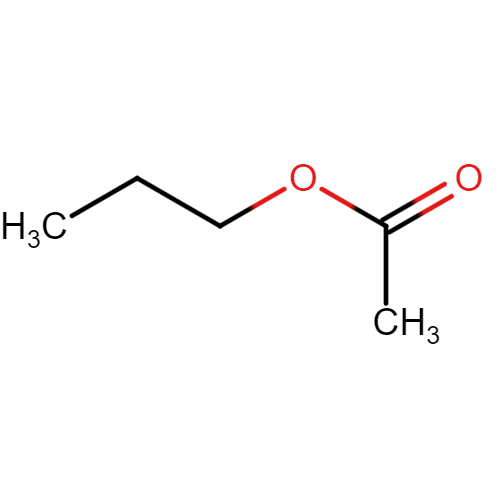Acetic acid, propyl ester
| Compound Structure: |

|
||||||||||||||||||||||||||||||||||||||||||||||||||
|---|---|---|---|---|---|---|---|---|---|---|---|---|---|---|---|---|---|---|---|---|---|---|---|---|---|---|---|---|---|---|---|---|---|---|---|---|---|---|---|---|---|---|---|---|---|---|---|---|---|---|---|
| Synonyms: | Propyl acetate;109-60-4;N-PROPYL ACETATE;Acetic acid, propyl ester;Propyl ethanoate;1-Acetoxypropane;1-Propyl acetate;n-Propyl ethanoate;Octan propylu;Acetic acid n-propyl ester;Acetate de propyle normal;n-Propyl acetate | ||||||||||||||||||||||||||||||||||||||||||||||||||
| Compound ID: | NMPC-482 | ||||||||||||||||||||||||||||||||||||||||||||||||||
| PubChem ID: | |||||||||||||||||||||||||||||||||||||||||||||||||||
| Molecular Formula: | C5H10O2 | ||||||||||||||||||||||||||||||||||||||||||||||||||
| Canonical SMILES: | CCCOC(=O)C | ||||||||||||||||||||||||||||||||||||||||||||||||||
| InChIKey: | YKYONYBAUNKHLG-UHFFFAOYSA-N | ||||||||||||||||||||||||||||||||||||||||||||||||||
| About the compound: | N-Propyl acetate, characterized by its molecular formula C5H10O2 and a molecular mass of 102.1317, is a versatile organic ester known for its clear, liquid state and a gentle, fruity scent. This compound, resulting from the combination of acetic acid and propanol, is employed as a solvent across the coatings, inks, and adhesives sectors and is valued in the flavor and fragrance industries for its appealing aroma[1]. With a moderate boiling point set at 102 °C and a density of approximately 0.888 g/mL at 20 °C, n-propyl acetate is not water-soluble but dissolves well in organic solvents. Its safety profile labels it as highly flammable, necessitating careful handling to avoid ignition risks. The main risks of exposure to this compound are through inhalation, ingestion, and contact with skin or eyes, highlighting the importance of appropriate safety precautions during its use. Despite its broad industrial applications, the flammability and possible health hazards associated with n-propyl acetate exposure underline the critical need for its careful management[2]. Propyl acetate, also known as propyl ethanoate, is an organic compound produced annually in significant quantities for use as a solvent. With an odor reminiscent of pears, it is commonly employed in fragrances and as a flavor additive. The compound is formed through the esterification of acetic acid with propan-1-ol, often using Fischer–Speier esterification with sulfuric acid as a catalyst and water produced as a byproduct. Reference 1. NIST Chemistry WebBook, SRD 69. Available at: https://webbook.nist.gov/cgi/cbook.cgi?ID=C109604&Mask=200 2. ChemSpider. Available at: http://www.chemspider.com/Chemical-Structure.7419.html GHS Hazard Statements • H225: Highly Flammable liquid and vapor [Danger Flammable liquids] • H319: Causes serious eye irritation [Warning Serious eye damage/eye irritation] • H336: May cause drowsiness or dizziness [Warning Specific target organ toxicity, single exposure; Narcotic effects] |
||||||||||||||||||||||||||||||||||||||||||||||||||
| Properties: |
Chemical
and Physical Properties
Source: PubChem |
||||||||||||||||||||||||||||||||||||||||||||||||||
| Source Species: |